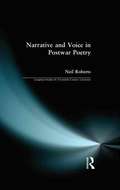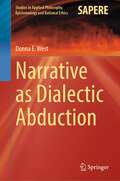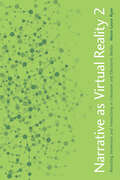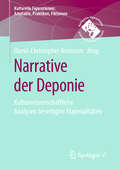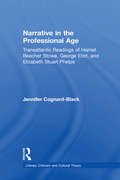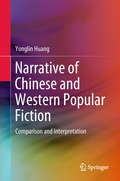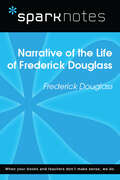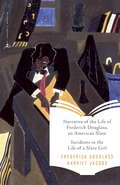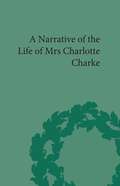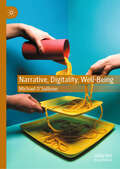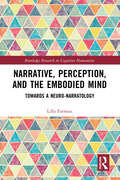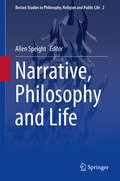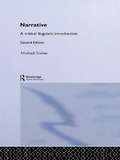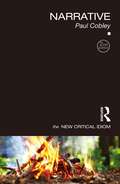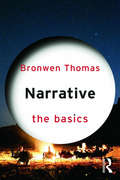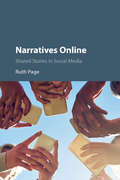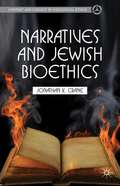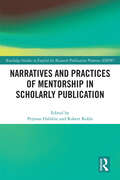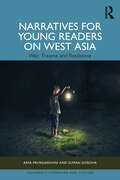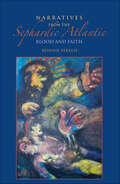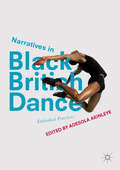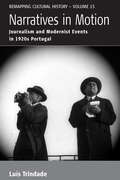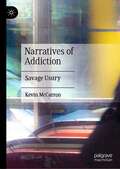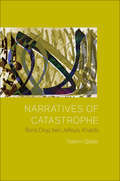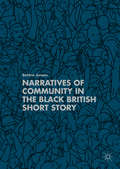- Table View
- List View
Narrative and Voice in Postwar Poetry (Longman Studies In Twentieth Century Literature)
by Neil RobertsPoetry in English since the Second World War has produced a number of highly original narrative works, as diverse as Derek Walcott's Omeros, Ted Hughes' Gaudete and Anne Stevenson's Correspondences. At the same time, poetry in general has been permeated by narrative features, particularly those linguistic characteristics that Mikhail Bakhtin considered peculiar to the novel, and which he termed "dialogic". This book examines the narrative and dialogic elements in the work of a range of poets from Britain, America, Ireland, Australia and the Caribbean, including poetry from the immediate postwar years to the contemporary, and novel-like narratives to personal lyrics. Its unifying theme is the way in which these poets, with such contrasting styles and from such varied backgrounds, respond to and creatively adapt the language-worlds, and hence the social worlds in which they live. The volume includes a detailed bibliography to assist students in further study, and will be a valuable resource to undergraduate and postgraduate students of contemporary poetry.
Narrative as Dialectic Abduction (Studies in Applied Philosophy, Epistemology and Rational Ethics #64)
by Donna E. WestThis book presents a fresh approach to the communicability of narratives, revealing the cognitive underpinnings of Charles Sanders Peirce’s pragmatistic model. It demonstrates how abductive processes modify habits of belief and action in what Peirce refers to as double consciousness. Abductions generated during double consciousness paradigms have increased efficacy compared to instinctual abductions. Novel inferences from working memory become consciously integrated with existing long-term memory units which permits fuller consideration of the plausibility of propositions. Special attention is given to children’s prelinguistic means to represent propositional or assertory conflicts, and to resolve these conflicts via listening and re-telling narrators’ accounts. Overall, this book serves both a theoretical and applied purpose. It is intended to support innovative therapeutic interventions to facilitate the (re)construction of narratives by adults and children. Its practical applications and theoretical grounding will appeal to graduate students and scholars alike, who wish to examine narrative as an interdisciplinary enterprise—an ontological and cultural phenomenon (narration by way of action/image sequences), not just a literary/linguistic paradigm. Ultimately, this account presents narrative as a modal forum to resolve logical and practical conflicts, compelling the interpreter to become an involved partner in the narrated event itself.
Narrative as Virtual Reality 2: Revisiting Immersion and Interactivity in Literature and Electronic Media
by Marie-Laure RyanRethinking textuality, mimesis, and the cognitive processing of texts in light of new modes of artistic world construction.Winner of the Aldo and Jeanne Scaglione Prize for Comparative Literary Studies from the Modern Language Association of AmericaIs there a significant difference between engagement with a game and engagement with a movie or novel? Can interactivity contribute to immersion, or is there a trade-off between the immersive "world" aspect of texts and their interactive "game" dimension? As Marie-Laure Ryan demonstrates in Narrative as Virtual Reality 2, the questions raised by the new interactive technologies have their precursors and echoes in pre-electronic literary and artistic traditions. Approaching the idea of virtual reality as a metaphor for total art, Ryan applies the concepts of immersion and interactivity to develop a phenomenology of narrative experience that encompasses reading, watching, and playing. The book weighs traditional literary narratives against the new textual genres made possible by the electronic revolution of the past thirty years, including hypertext, electronic poetry, interactive drama, digital installation art, computer games, and multi-user online worlds like Second Life and World of Warcraft.In this completely revised edition, Ryan reflects on the developments that have taken place over the past fifteen years in terms of both theory and practice and focuses on the increase of narrativity in video games and its corresponding loss in experimental digital literature. Following the cognitive approaches that have rehabilitated immersion as the product of fundamental processes of world-construction and mental simulation, she details the many forms that interactivity has taken—or hopes to take—in digital texts, from determining the presentation of signs to affecting the level of story.
Narrative der Deponie: Kulturwissenschaftliche Analysen beseitigter Materialitäten (Kulturelle Figurationen: Artefakte, Praktiken, Fiktionen)
by David-Christopher AssmannDie Deponie ist eine paradoxe, risikobehaftete Einrichtung. Die moderne Gesellschaft erhofft sich durch sie, weggeworfene, unbrauchbare oder gefährliche Dinge, Stoffe oder Substanzen ein für alle Mal sich selbst überlassen zu können. Zugleich erfordern die entsprechenden Ablagerungsstellen erhebliche Aufmerksamkeit und technischen Aufwand. Auch wenn die Deponie ihre Legitimation aus der Annahme zieht, den auf ihr angesammelten Müll zu domestizieren, ist sie trotz aller Versicherungen und Vorkehrungen nämlich eines gerade nicht: abgeschlossen. Die Beiträge dieses Bandes nehmen diese Beobachtung zum Ausgangspunkt. Sie fragen nach den ökologisch problematischen und ästhetisch produktiven Implikationen der Anhäufung beseitigter Materialitäten und deren Verknüpfungen mit literarisch-kulturellen Diskursen. In exemplarischen Probebohrungen eröffnen sie Perspektiven einer literatur-, medien- und kulturwissenschaftlichen Untersuchung der Deponie. Zwei bisher eher getrennt voneinander operierende akademische Wissensbereiche werden dazu zusammengebracht: Studien auf dem Gebiet des Ecocriticism mit solchen der kulturwissenschaftlichen Analyse von Praktiken und Poetiken des Sammelns und Archivierens. Die Deponie wird so sichtbar als ein dynamisch-agentielles Konglomerat aus sozialen Praktiken, Diskursen und Materialitäten, mit denen Narrative u.a. aus Literatur, Fotografie, Film und Computerspielen verwoben sind.
Narrative in the Professional Age: Transatlantic Readings of Harriet Beecher Stowe, Elizabeth Stuart Phelps, and George Eliot (Literary Criticism And Cultural Theory Ser.)
by Jennifer Cognard-BlackChallenging previous studies that claim anxiety and antagonism between transatlantic Victorian authors, Jennifer Cognard-Black uncovers a model of reciprocal influence among three of the most popular women writers of the era. Combining analyses of personal correspondence and print culture with close readings of key narratives, this study presents a
Narrative of Chinese and Western Popular Fiction: Comparison And Interpretation
by Yonglin HuangThis book presents a comprehensive and systematic study of the narrative history and narrative methods of Chinese and Western popular fiction from the perspectives of narratology, comparative literature, and art and literature studies by adopting the methodology of parallel comparison. The book is a pioneering work that systematically investigates the similarities and differences between Chinese and Western popular fiction, and traces the root causes leading to the differences. By means of narrative comparison, it explores the conceptual and spiritual correlations and differences between Chinese and Western popular fiction and, by relating them to the root causes of cultural spirit, allows us to gain an insight into the cultural heritage of different nations. The book is structured in line with a cause-and-effect logical sequence and moves from the macroscopic to the microscopic, from history to reality, and from theory to practice. The integration of macro-level theoretical studies and micro-level case studies is both novel and effective. This book was awarded Second Prize at the Sixth Outstanding Achievement Awards in Scientific Research for Chinese Institutions of Higher Learning (Humanities & Social Sciences, 2013).
Narrative of the Life of Frederick Douglass (SparkNotes Literature Guide Series)
by SparkNotesNarrative of the Life of Frederick Douglass (SparkNotes Literature Guide) by Frederick Douglass Making the reading experience fun! Created by Harvard students for students everywhere, SparkNotes is a new breed of study guide: smarter, better, faster. Geared to what today's students need to know, SparkNotes provides: *Chapter-by-chapter analysis *Explanations of key themes, motifs, and symbols *A review quiz and essay topicsLively and accessible, these guides are perfect for late-night studying and writing papers
Narrative of the Life of Frederick Douglass, an American Slave & Incidents in the Life of a Slave Girl
by Frederick Douglass Harriet JacobsThis Modern Library Paperback Classics edition combines the two most important African American slave narratives into one volume. <P><P>Frederick Douglass's Narrative, first published in 1845, is an enlightening and incendiary text. Born into slavery, Douglass became the preeminent spokesman for his people during his life; his narrative is an unparalleled account of the dehumanizing effects of slavery and Douglass's own triumph over it. <P><P>Like Douglass, Harriet Jacobs was born into slavery, and in 1861 she published Incidents in the Life of a Slave Girl, now recognized as the most comprehensive antebellum slave narrative written by a woman. Jacobs's account broke the silence on the exploitation of African American female slaves, and it remains crucial reading. <P><P>These narratives illuminate and inform each other. This edition includes an incisive Introduction by Kwame Anthony Appiah and extensive annotations.
Narrative of the Life of Mrs Charlotte Charke (Pickering Women's Classics)
by Robert M RehderIn this picaresque novel, Charlotte Clarke recalls her life as an actress, and in particular, the difficulties facing a woman trying to make her way in a man's world. The issues of women's writing, education, motherhood, sexuality, and cross-dressing all come under scrutiny.
Narrative, Digitality, Well-Being
by Michael O’SullivanNarrative, Digitality, Well-Being Narrative, Digitality, Wellbeing adopts a transdisciplinary approach in exploring new forms of narrative that have emerged in a digital age, an age of new online practices that are both associated with increased risk and enhanced sense of identity. The book examines new literary narratives, new philosophies of digitality, and new approaches to cross-disciplinary work between narrative theory and psychology in the context of digital environments, interactions, and practices. It also explores through textual analysis and quantitative and qualitative analysis how users shape and understand these new narrative interactions for their own wellbeing and how educators assess the relationships between narratives and wellbeing in the classroom and lecture theatre. The book argues that theories of narrative need to be updated to account for these new forms of narrative and to account for the new ways narrative is employed by users to enhance wellbeing.
Narrative, Perception, and the Embodied Mind: Towards a Neuro-narratology (Routledge Research in Cognitive Humanities)
by Lilla FarmasiThis book encourages cross-disciplinary dialogues toward introducing a new framework for neuro-narratology, expanding on established theory within cognitive narratology to more fully encompass the different faculties involved in the reading process. In order to investigate narrative cognition, the book traces the ways in which cognitive patterns of embodiment – and the neural connections that comprise them – in the reading process are translated into patterns in narrative fiction. Drawing theories of episodic memories and nonvisual perception of space, Farmasi draws on theories of episodic memories and nonvisual perception of space in analyzing a range of narratives from 20th century prose. The first set of analyses shines a light on perception and emotion in narrative discourses and the construction of storyworlds, while the second foregrounds the reader’s experience. The volume makes the case for the fact that narratives need to be understood as dynamic elements of the interaction between mind, body, and environment, generating new insights and inspiring further research. This book will appeal to scholars interested in narrative theory, literary studies, cognitive science, neuroscience, and philosophy
Narrative, Philosophy and Life
by Allen SpeightThis notable collection provides an interdisciplinary platform for prominent thinkers who have all made significant recent contributions to exploring the nexus of philosophy and narrative. It includes the latest assessments of several key positions in the current philosophical debate. These perspectives underpin a range of thematic strands exploring the influence of narrative on notions of selfhood, identity, temporal experience, and the emotions, among others. Drawing from the humanities, literature, history and religious studies, as well as philosophy, the volume opens with papers on narrative intelligence and the relationship between narrative and agency. It features special sections of in-depth commentary on a range of topics. How, for example, do narrative and philosophical biography interact? Do celebrated biographical and autobiographical accounts of the lives of philosophers contribute to our understanding of their work? This new volume has a substantive remit that incorporates the intercultural religious view of philosophy's links to narrative together with its many secular aspects. A valuable new resource for more advanced scholars in all its constituent disciplines, it represents a significant addition to the literature of this richly productive area of research.
Narrative: A Critical Linguistic Introduction (Interface Ser.)
by Michael ToolanThis classic text has been substantially rewritten. Narrative explores a range of written, spoken, literary and non-literary narratives. It shows what systematic attention to language can reveal about the narratives themselves, their tellers, and those to whom they are addressed.New material includes sections on gendered narrative, film narrative and a discussion of ways in which the internet and global television are changing conceptions of narrative.
Narrative: A Critical Linguistic Introduction (The New Critical Idiom)
by Paul CobleyHuman beings have constantly told stories, presented events and placed the world into narrative form. This activity suggests a very basic way of looking at the world, yet, this book argues, even the most seemingly simple of stories is embedded in a complex network of relations. Paul Cobley traces these relations, considering the ways in which humans have employed narrative over the centuries to ‘re-present’ time, space and identity. This second, revised and fully updated edition of the successful guidebook to narrative covers a range of narrative forms and their historical development from early oral and literate forms through to contemporary digital media, encompassing Hellenic and Hebraic foundations, the rise of the novel, realist representations, narratives of imperialism, modernism, cinema, postmodernism and new technologies. A final chapter reviews the way that narrative theory in the last decade has re-orientated definitions of narrative. Written in a clear, engaging style and featuring an extensive glossary of terms, this is the essential introduction to the history and theory of narrative.
Narrative: Stories And Storytelling In The Digital Age (The Basics)
by Bronwen ThomasProviding an up-to-date and accessible overview of the essentials of narrative theory, Narrative: The Basics guides the reader through the major approaches to the study of narrative, using contemporary examples from a wide range of narrative forms to answer key questions including: What is narrative? What are the "universals" of narrative? What is the relationship between narrative and ideology? Does the reader have a role in narrative? Has the digital age brought radically new forms of narrative? Each chapter introduces key theoretical terms, providing thinking points and suggestions for further study. With an emphasis on applying theory to example studies, it is an ideal introduction to the current study of narrative.
Narratives Online: Shared Stories in Social Media
by Ruth PageStories are shared by millions of people online every day. They post and re-post interactions as they re-tell and respond to large-scale mediated events. These stories are important as they can bring people together, or polarise them in opposing groups. Narratives Online explores this new genre - the shared story - and uses carefully chosen case-studies to illustrate the complex processes of sharing as they are shaped by four international social media contexts: Wikipedia, Facebook, Twitter and YouTube. Building on discourse analytic research, Ruth Page develops a new framework - 'Mediated Narrative Analysis' - to address the large scale, multimodal nature of online narratives, helping researchers interpret the micro- and macro-level politics that are played out in computer-mediated communication.
Narratives and Jewish Bioethics
by Jonathan K. CraneNarratives and Jewish Bioethics searches for answers to the critical question of what roles ancient narratives play in creating modern norms by Jewish bioethicists utilizing the Jewish textual tradition.
Narratives and Practices of Mentorship in Scholarly Publication (Routledge Studies in English for Research Publication Purposes)
by Pejman Habibie Robert KohlsThis edited volume explores mentorship in knowledge production and dissemination and examines its implications for academic lives and careers of novice scholarly writers.By bringing together experts in a variety of areas in applied linguistics, the book addresses the complex topic of mentorship in scholarly publication practices of junior scholars. Drawing on the perspectives and experiences of novice scholars, supervisors, practitioners, and researchers, it intends to demystify the socialization process of junior academics and help paint a richer and more nuanced picture of the practices, experiences, and challenges of mentorship in writing for publication. An important aspect of the book is a serious attempt to explore the experiences of different stakeholders both through empirical research and personal (hi)stories and accounts.The book acts as a valuable resource for graduate students and both novice and established scholars looking to build a more holistic understanding of mentorship in scholarly publication today, in such fields as English for research publication purposes, applied linguistics, and TESOL.
Narratives for Young Readers on West Asia: War, Trauma and Resilience (Children's Literature and Culture)
by Arya Priyadarshini Suman SigrohaThrough critical textual analysis of the trauma narratives for young readers written in English on political conflicts and the violation of humanitarian values, this book recovers the response to trauma from the margins of the survivor spectrum. By focusing on the experiences of Syrian and Palestinian children, it elucidates how their stories are often portrayed in a manner that not only emphasises their resilience but also underscores the gravity of the experiences. The book sheds light on the multifaceted impact of the conflicts on the region and the psychological toll they take on the younger generation through the representation of their experiences in these narratives. The harrowing experiences of refugees, war victims and displaced persons from non- Western countries often lack a voice in the advancement of the trauma discourse. The theoretical approach utilised in this research thus employs child and adolescent psychoanalysis to extend the existing approach to trauma studies, and brings the neglected and under- represented trauma narratives to the fore. Many of the atrocities discussed in this book continue in the present times, which makes the study of this subject matter even more vital. The ongoing war between Israel and Hamas that has killed thousands of people in the region within a short space of time makes this research even more pertinent and urgent, as the widespread violence and suffering has echoed the trauma that the region has undergone in the past decades.
Narratives from the Sephardic Atlantic: Blood and Faith (Sephardi and Mizrahi Studies)
by Ronnie PerelisIdentity, family, and community unite three autobiographical texts by New World crypto-Jews, or descendants of Jews who were forced to convert to Christianity in 17th-century Iberia and Spanish America. Ronnie Perelis presents the fascinating stories of three men who were caught within the matrix of inquisitorial persecution, expanding global trade, and the network of crypto-Jewish activity. Each text, reflects the unique experiences of the author and illuminates their shared, deeply rooted attachment to Iberian culture, their Atlantic peregrinations, and their hunger for spiritual enlightenment. Through these writings, Perelis focuses on the social history of transatlantic travel, the economies of trade that linked Europe to the Americas, and the physical and spiritual journeys that injected broader religious and cultural concerns into this complex historical moment.
Narratives in Black British Dance
by Adesola AkinleyeThis book explores Black British dance from a number of previously-untold perspectives. Bringing together the voices of dance-artists, scholars, teachers and choreographers, it looks at a range of performing arts from dancehall to ballet, providing valuable insights into dance theory, performance, pedagogy, identity and culture. It challenges the presumption that Blackness, Britishness or dance are monolithic entities, instead arguing that all three are living networks created by rich histories, diverse faces and infinite future possibilities. Through a variety of critical and creative essays, this book suggests a widening of our conceptions of what British dance looks like, where it appears, and who is involved in its creation.
Narratives in Motion: Journalism and Modernist Events in 1920s Portugal (Remapping Cultural History #15)
by TrindadeInterwar Portugal was in many ways a microcosm of Europe's encounter with modernity: reshaped by industrialization, urban growth, and the antagonism between liberalism and authoritarianism, it also witnessed new forms of media and mass culture that transformed daily life. This fascinating study of newspapers in 1920s Portugal explores how the new "modernist reportage" embodied the spirit of the era while mediating some of its most spectacular episodes, from political upheavals to lurid crimes of passion. In the process, Luís Trindade illuminates the twofold nature of that journalism-both historical account and material object, it epitomized a distinctly modern entanglement of narrative and event.
Narratives of Addiction: Savage Usury
by Kevin McCarronNarratives of Addiction: Savage Usury is the first book to argue, in the face of more than a century’s received wisdom, that drug addiction and alcoholism are undoubtedly evidence of individual moral flaws. However, the sense of morality that underlies this book is completely severed from Christianity. Instead, it is influenced in particular by the writings of the nineteenth-century German philosophers Arthur Schopenhauer and Frederick Nietzsche, both of whom insisted that a genuine morality was actually incompatible with Christianity. The sequence of chapters moves from addictions on the streets, into rehab clinics, and finally into the meetings of Alcoholics Anonymous and Narcotics Anonymous. This is the first book to argue that the search for pleasure drives alcoholism and drug addiction and not the “numbing of pain”. Throughout the book I reject the claims of the medical profession, as embodied by the American Medical Association, that drug addiction and alcoholism are diseases, and further argue that they do not have the authority to tell hundreds of millions of Americans that addiction is not a moral failing. I also query throughout the book the claims of neuroscience, psychology, and the social sciences that addictions to alcohol and drugs are attributable to causes that their specific disciplines are best suited to understand. I argue that there is nothing complex about addiction: it is a simple behavioural disorder. The language routinely employed to discuss addiction is similarly not complex, just confused, and so it is also the rhetoric of addiction discourse, especially its use of simile, metaphor and euphemism, that this book evaluates.
Narratives of Catastrophe: Boris Diop, ben Jelloun, Khatibi
by Nasrin QaderNarratives of Catastrophe tells the story of the relationship between catastrophe, in the senses of "down turn" and "break," and narration as "recounting" in the senses suggested by the French term récit in selected texts by three leading writers from Africa. Qader's book begins by exploring the political implications of narrating catastrophic historical events. Through careful readings of singular literary texts on the genocide in Rwanda and on Tazmamart, a secret prison in Morocco under the reign of Hassan II, Qader shows how historical catastrophes enter language and how this language is marked by the catastrophe it recounts. Not satisfied with the extra-literary characterizations of catastrophe in terms of numbers, laws, and naming, she investigates the catastrophic in catastrophe, arguing that catastrophe is always an effect of language andthought,. The récit becomes a privileged site because the difficulties of thinking and speaking about catastrophe unfold through the very movements of storytelling.This book intervenes in important ways in the current scholarship in the field of African literatures. It shows the contributions of African literatures in elucidating theoretical problems for literary studies in general, such as storytelling's relationship to temporality, subjectivity, and thought. Moreover, it addresses the issue of storytelling, which is of central concern in the context of African literatures but still remains limited mostly to the distinction between the oral and the written. The notion of récit breaks with this duality by foregrounding the inaugural temporality of telling and of writing as repetition.The final chapters examine catastrophic turns within the philosophical traditions of the West and in Islamic thought, highlighting their interconnections and differences.
Narratives of Community in the Black British Short Story
by Bettina JansenNarratives of Community in the Black British Short Story offers the first systematic study of black British short story writing, tracing its development from the 1950s to the present with a particular focus on contemporary short stories by Hanif Kureishi, Jackie Kay, Suhayl Saadi, Zadie Smith, and Hari Kunzru. By combining a postcolonial framework of analysis with Jean-Luc Nancy’s deconstructive philosophy of community, the book charts key tendencies in black British short fiction and explores how black British writers use the short story form to combat deeply entrenched notions of community and experiment with non-essentialist alternatives across differences of ethnicity, culture, religion, and nationality.
